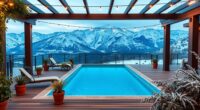Before building a rooftop infinity pool, you must assess if your building’s foundation and structure can handle the added weight, water, and fixtures. Reinforce the concrete slabs with durable materials and corrosion-resistant rebar, and choose waterproofing systems that prevent leaks and water damage. You should also consider wind loads and environmental factors to guarantee stability. Proper maintenance and inspections are key to long-term safety. Keep exploring to discover detailed steps for a safe, resilient design.
Key Takeaways
- Conduct thorough structural assessments and geotechnical surveys to ensure the building’s foundation can support the added weight of the pool.
- Use reinforced concrete with corrosion-resistant materials and proper waterproofing to handle water pressure and environmental exposure.
- Design effective drainage and wind barriers to prevent water accumulation and withstand high wind loads on rooftop structures.
- Incorporate load distribution systems like transfer slabs or beams to evenly spread the pool’s weight across the building’s foundation.
- Plan for ongoing maintenance and inspections to preserve structural integrity, waterproofing, and water quality over the pool’s lifespan.
Assessing Structural Load-Bearing Capacity
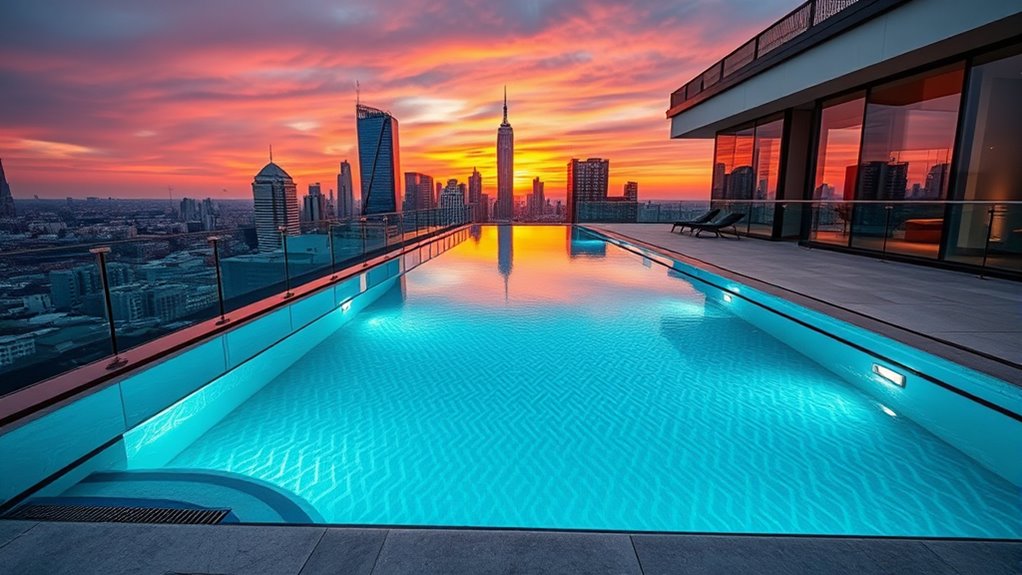
Before installing a rooftop infinity pool, you need to carefully assess the building’s structural load-bearing capacity. You should consult a structural engineer to evaluate if the existing foundation can support the weight of the pool, water, and additional fixtures. The engineer will analyze the building’s current load limits and determine if reinforcement is necessary. Factors like the building’s age, materials, and design influence its ability to handle the extra weight. You’ll need detailed calculations to guarantee safety and compliance with local codes. Ignoring this step could lead to structural failure or collapse, risking damage and safety hazards. Conducting a thorough assessment early on helps you identify potential issues, so you can plan for necessary reinforcements before proceeding. Additionally, understanding the building’s load-bearing capacity is crucial for ensuring long-term safety and stability of the structure.
Reinforcement and Material Selection
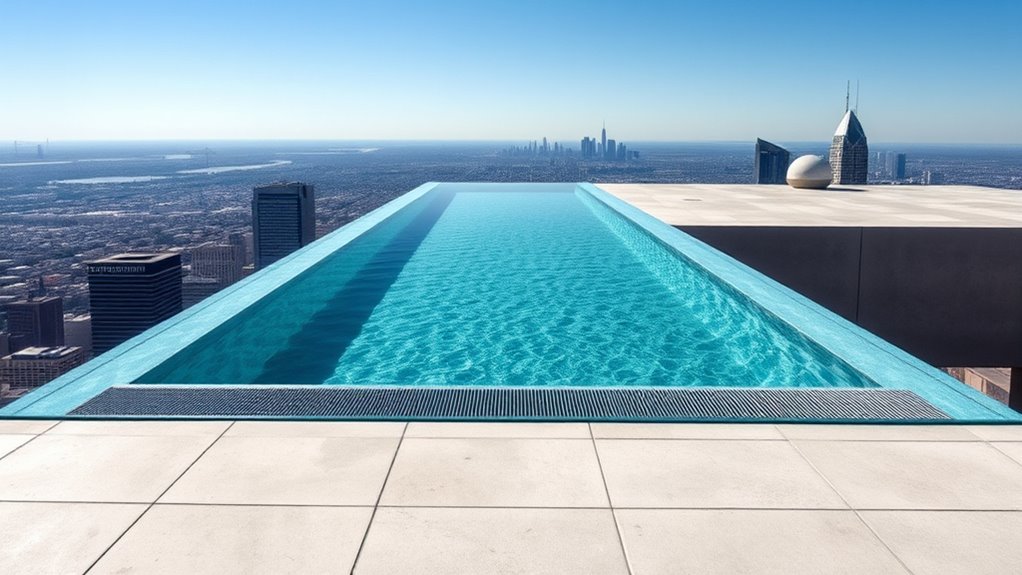
Selecting the right reinforcement and materials is essential to guarantee your rooftop infinity pool remains safe and durable. You need strong concrete mixes, corrosion-resistant reinforcement, and high-quality materials that withstand weather and water exposure. Reinforcement bars (rebar) must be correctly placed to handle tension, while choosing durable concrete prevents cracking and deterioration. Opt for materials suited to your climate, such as stainless steel or epoxy-coated rebar, to prevent corrosion. Here’s a quick guide:
| Material Type | Purpose | Benefits |
|---|---|---|
| High-strength concrete | Structural integrity | Durability, crack resistance |
| Epoxy-coated rebar | Reinforcement in wet environments | Corrosion resistance |
| Waterproof aggregates | Reduces permeability | Longer lifespan |
Proper tuning techniques can also ensure the longevity and optimal performance of your pool’s mechanical systems.
Waterproofing and Waterproofing Systems
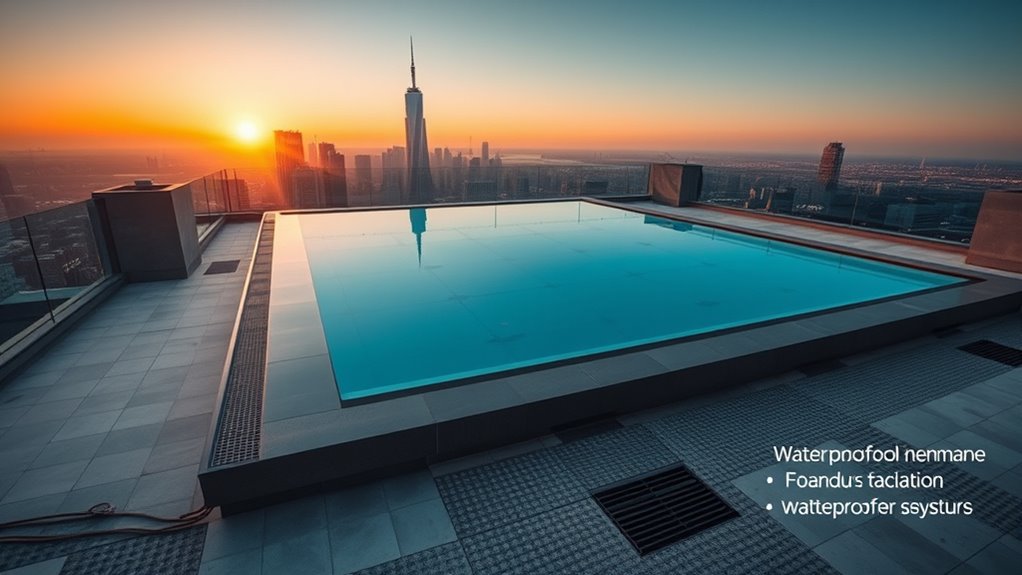
Waterproofing is vital for your rooftop infinity pool’s durability, and choosing the right materials makes a big difference. You should also pay attention to the drainage system to prevent water buildup and damage. Proper maintenance ensures your waterproofing remains effective and extends the pool’s lifespan. Additionally, selecting environmentally friendly building materials can contribute to sustainable construction practices.
Waterproofing Material Types
Have you ever wondered what types of waterproofing materials are best suited for rooftop infinity pools? Choosing the right material is vital for durability and leak prevention. Here are three top options:
- Liquid-applied membranes – These seamless coatings, like polyurethane or bituminous coatings, create a flexible, waterproof layer that adheres well to complex surfaces.
- Sheet membranes – Made from PVC or EPDM, these prefabricated sheets are installed with adhesives or heat welding, providing a reliable barrier.
- Liquid membranes with reinforcing fabrics – Combining liquid coatings with fabrics enhances strength and crack-bridge capabilities, ideal for movement-prone substrates. Additionally, understanding the contrast ratio of your waterproofing system can help evaluate how well it will perform in different lighting conditions, ensuring long-term performance and protection.
Selecting the appropriate type depends on your project’s specifics, but all offer reliable waterproofing to guarantee your infinity pool stands the test of time.
Drainage System Importance
Why is a reliable drainage system essential for rooftop infinity pools? Without proper drainage, water can accumulate, causing structural damage, leaks, and mold. It helps manage overflow during heavy rains and prevents water from seeping into the building’s foundation. A well-designed drainage system ensures safety, durability, and reduces maintenance costs. It also protects waterproofing layers from water pressure that can cause deterioration over time. Consider this table to understand key drainage features:
| Feature | Importance | Example |
|---|---|---|
| Drain Placement | Prevents water pooling | Near pool edges |
| Slope Design | Ensures water flows correctly | 1-2% gradient |
| Material Quality | Stops leaks and corrosion | High-grade PVC or concrete |
| Overflow System | Manages excess water | Overflow channels |
| Maintenance Access | Simplifies inspections and repairs | Access panels or cleanouts |
Additionally, incorporating proper drainage practices aligns with environmental considerations and helps maintain the longevity of waterproofing systems.
Maintenance & Longevity
Proper maintenance of waterproofing systems is essential to guarantee your rooftop infinity pool remains durable and leak-free over time. Regular inspections help identify early signs of wear, cracks, or deterioration. To extend the lifespan of your waterproofing, focus on these key actions: 1. Schedule routine visual inspections to detect damage or pooling issues. 2. Clean the surface regularly, removing debris that can weaken the membrane. 3. Reapply or repair sealants and waterproof coatings as needed, especially after extreme weather or heavy use. 4. Use appropriate waterproofing systems designed specifically for rooftop pools to ensure maximum protection and longevity.
Designing for Wind and Environmental Factors
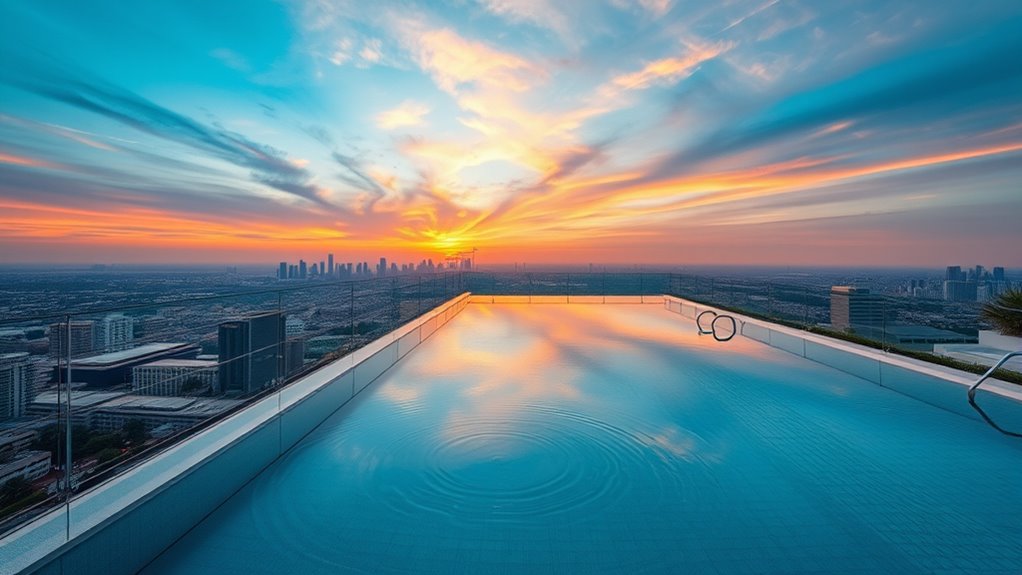
When designing your rooftop infinity pool, you need to account for wind load considerations to guarantee stability and safety. Additionally, environmental impact factors like local climate and pollution can influence material choices and maintenance plans. Addressing these factors early helps create a resilient, sustainable pool that withstands the elements. Incorporating lifestyle considerations such as energy efficiency and user comfort can further optimize your design.
Wind Load Considerations
Designing rooftop infinity pools requires careful consideration of wind loads, as high-rise buildings are subject to strong and variable wind pressures. You need to assess how wind forces impact the pool’s structure and safety. First, evaluate local wind patterns and velocity profiles to predict maximum loads. Second, incorporate aerodynamic design features—such as windbreaks or rounded edges—to reduce pressure differentials. Third, select materials and reinforcement that can withstand dynamic wind forces, minimizing movement or damage. Proper anchoring systems are critical for stability, especially during gusts. Addressing these factors ensures your infinity pool remains safe, durable, and comfortable even under challenging wind conditions, protecting both the structure and its users from potential hazards. Additionally, understanding how to budget for construction costs can help plan for the necessary structural reinforcements and design features.
Environmental Impact Factors
Environmental factors profoundly influence the safety and longevity of rooftop infinity pools, especially in areas prone to harsh weather conditions. Wind, rain, and temperature fluctuations can impact structural integrity and water safety. To mitigate these effects, consider designing with wind barriers, selecting corrosion-resistant materials, and ensuring proper drainage. Additionally, understanding sound healing science can inspire innovative design elements that promote relaxation and well-being around the pool area.
Integration With Building Foundations
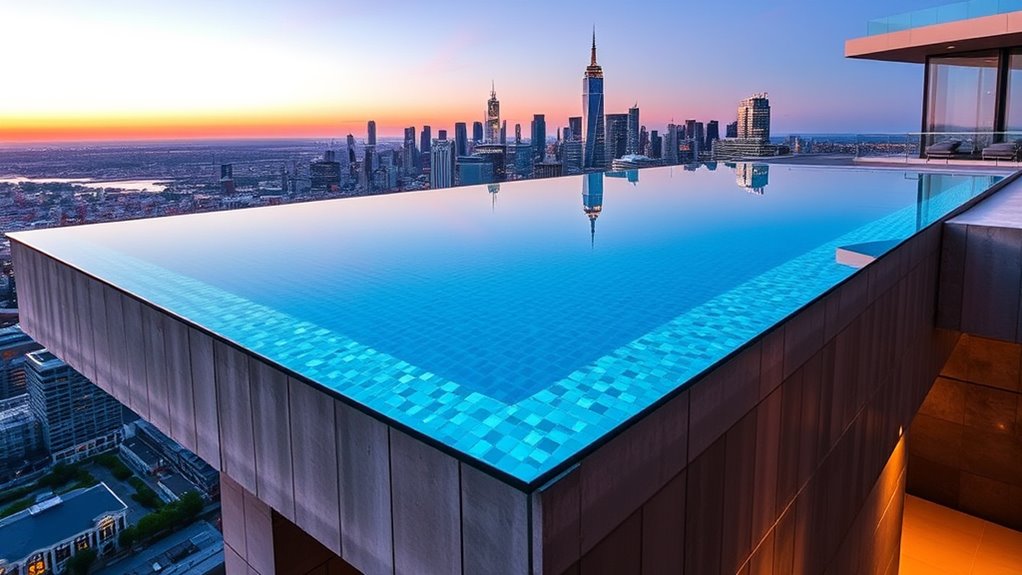
Integrating rooftop infinity pools with building foundations requires careful structural planning to guarantee stability and safety. Your design must account for additional loads and ensure the building can support the weight of the water, structure, and occupants. To achieve this, consider these key steps:
Effective rooftop infinity pools demand meticulous structural planning to ensure safety and stability.
- Conduct thorough geotechnical assessments to understand soil bearing capacity.
- Design reinforced concrete slabs tailored to handle the increased load, avoiding flexing or cracking.
- Incorporate load distribution systems, such as beams or transfer slabs, to evenly spread weight across the foundation.
- Consult with a structural engineer experienced in somatic therapy to ensure the design accommodates all safety and stability considerations.
Maintenance and Long-Term Durability

Maintaining rooftop infinity pools requires ongoing vigilance to guarantee their long-term durability. Regular inspections help identify leaks, cracks, or structural issues early, preventing costly repairs. Keep the water chemistry balanced to avoid corrosion and damage to the pool’s surface and equipment. Clean the filtration system and skimmers frequently to ensure proper circulation and water quality. Protect the pool from harsh weather conditions with appropriate covers or enclosures. Address any signs of wear promptly, such as peeling tiles or erosion around the edges. Proper maintenance extends the lifespan of your pool, preserves its aesthetic appeal, and ensures safety for users. By staying proactive and following a consistent maintenance routine, you’ll keep your rooftop infinity pool in excellent condition for years.
Frequently Asked Questions
What Permits Are Required for Rooftop Infinity Pools?
You need to obtain building permits from your local authorities before installing a rooftop infinity pool. Check with your city or county planning department to understand specific requirements, which often include structural integrity assessments, safety measures, and zoning approvals. You might also need permits for plumbing, electrical work, and water use. Securing these permits guarantees your project complies with regulations and avoids future legal or safety issues.
How Do Temperature Fluctuations Affect Pool Materials?
Temperature fluctuations are like a rollercoaster for your pool materials, causing expansion and contraction that can lead to cracks or leaks. When it gets hot, materials expand; in cold weather, they contract. This stress can weaken the structure over time. To protect your investment, choose materials with good thermal resistance, and consider insulation and proper sealing to minimize damage caused by these temperature swings.
Can Existing Structures Support a Rooftop Infinity Pool?
Yes, existing structures can support a rooftop infinity pool if they’re properly assessed. You need to hire a structural engineer to evaluate the load-bearing capacity, considering the weight of the water, pool materials, and additional features. Reinforcements might be necessary to ensure safety and stability. Don’t skip this step, as overlooking structural integrity risks damage or collapse. Proper planning guarantees your rooftop pool is both beautiful and secure.
What Safety Features Are Essential for Rooftop Pools?
Like Icarus, you want to enjoy your rooftop pool safely. Essential safety features include sturdy barriers or railings that meet height and strength standards, non-slip surfaces around the pool, and reliable drainage systems to prevent water accumulation. You should also install anti-slip mats, pool covers when not in use, and proper lighting for visibility at night. Regular inspections and adherence to local building codes guarantee your elevated oasis remains secure and enjoyable.
How Does Pool Design Impact Building Energy Efficiency?
Your pool design directly influences your building’s energy efficiency by affecting insulation, shading, and ventilation. Opt for energy-efficient pumps, heaters, and LED lighting to reduce power use. Incorporate shading elements like pergolas or trees to minimize heat gain. Properly insulating the pool and surrounding areas helps maintain desired temperatures, lowering heating costs. Thoughtful design choices can markedly cut energy consumption while enhancing your rooftop pool’s sustainability and comfort.
Conclusion
Building a rooftop infinity pool is like weaving a delicate tapestry—every thread must be sturdy and perfectly placed. By understanding load capacity, choosing the right materials, and planning for weather, you guarantee your oasis stands tall and serene for years to come. Think of it as sculpting a masterpiece on the rooftop canvas; with careful planning, your dream pool will be a breathtaking view that elevates your space—literally.


